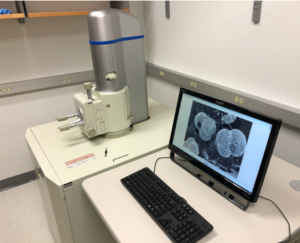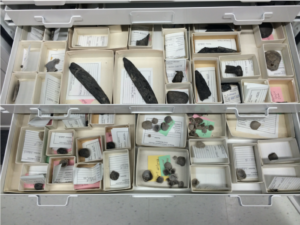The Paleontology laboratory is a modern facility with a variety of teaching and research equipment. The laboratory is amply equipped with binocular and petrographic microscopes and several computer workstations. Additionally, the laboratory is equipped with fossil preparation equipment including mechanical preparation tools (e.g., drills, engravers, pneumatic scribes, and air abrasive facilities, an acid-proccessing facility with fume hood and processing area, splitters, seives, and shakers for sediment and grain-size analyses, and complete digital imaging systems for macro and micropaleontolgical work. Elsewhere in the Department and science building are thin-sectioning and rock-sawing machines.  Additionally, the Geology Department is home to a Rigaku MiniFlex Powder X-ray diffractometer and a JEOL JSM-6010LA scanning electron microscope with secondary and backscatter imaging and EDS capability that are extensively used in paleontological research.
Additionally, the Geology Department is home to a Rigaku MiniFlex Powder X-ray diffractometer and a JEOL JSM-6010LA scanning electron microscope with secondary and backscatter imaging and EDS capability that are extensively used in paleontological research.
 The Paleontology Lab is home to more than 15,000 individual fossil specimens that are used for research purposes. A majority of these are fossil bivalve mollusks, from the Triassic Period and come from all across the globe.
The Paleontology Lab is home to more than 15,000 individual fossil specimens that are used for research purposes. A majority of these are fossil bivalve mollusks, from the Triassic Period and come from all across the globe.